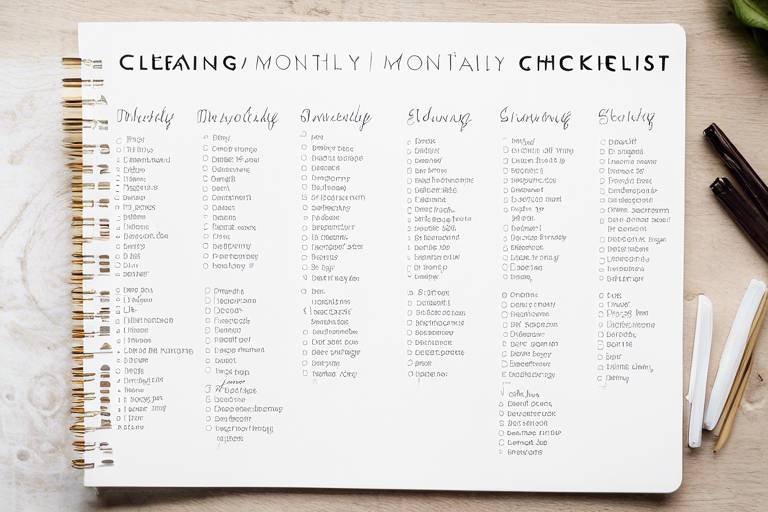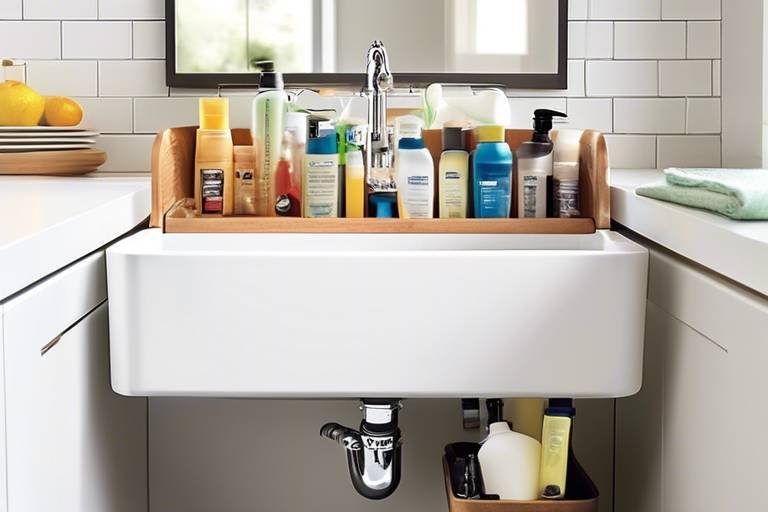Tips for Minimalist Living with Children
Living a minimalist lifestyle with children may seem like a daunting task, but with the right strategies, it can be a rewarding and enriching experience for the whole family. By simplifying your home, routines, and belongings, you can create a peaceful and organized environment that promotes creativity, independence, and mindfulness. Embracing minimalism with children is not about deprivation but rather about focusing on what truly matters and letting go of excess clutter and distractions.
One of the key aspects of minimalist living with children is decluttering. Involving children in the decluttering process can teach them valuable lessons about the importance of simplicity and mindful consumption from a young age. By encouraging them to let go of items they no longer use or need, you can help them develop a sense of gratitude and appreciation for the things they have.
When it comes to organizing kid-friendly spaces, it's essential to strike a balance between functionality and aesthetics. Designing spaces that are both practical and visually appealing can inspire creativity and independence in children. Consider creating designated areas for play, study, and relaxation, ensuring that each space serves a specific purpose while maintaining a cohesive and clutter-free environment.
Implementing a toy rotation system is another effective way to promote minimalism with children. By rotating toys regularly, you can reduce clutter, enhance playtime creativity, and teach children the value of cherishing and caring for their belongings. This system not only helps in maintaining a tidy space but also encourages children to appreciate the toys they have and make the most out of them.
Embracing sustainable practices is a fundamental aspect of minimalist living with children. By incorporating eco-friendly habits into your daily routines, such as reducing waste, recycling, and choosing sustainable products, you can instill a sense of environmental responsibility in your children. Teaching them the importance of caring for the planet and making conscious choices can have a lasting impact on their values and behaviors.
Shifting your mindset from quantity to quality is crucial when adopting a minimalist lifestyle with children. Prioritizing quality over quantity when it comes to toys, clothing, and other possessions can help instill a sense of intentionality and appreciation for well-made items. Encouraging children to value experiences over material possessions can foster a deeper sense of fulfillment and contentment.
Creating meaningful experiences with your children is at the heart of minimalist living. Engaging in outdoor adventures, creative projects, and quality time together can strengthen family bonds and create lasting memories. By focusing on shared experiences rather than material goods, you can nurture a sense of connection and joy that goes beyond material possessions.
Educating children about financial literacy is an essential aspect of raising mindful and responsible individuals. Teaching them the value of money, the importance of saving, budgeting, and making thoughtful purchasing decisions can empower them to make informed choices and develop healthy financial habits from a young age. By instilling financial literacy skills, you can equip your children with the tools they need to navigate the complexities of the modern world.
Cultivating gratitude and mindfulness within your family is a powerful way to enhance the quality of your lives and relationships. By appreciating the simple joys of life, practicing mindfulness in daily activities, and fostering a sense of gratitude for what you have, you can create a harmonious and fulfilling family dynamic. Encouraging moments of reflection, gratitude, and presence can deepen your connection with each other and the world around you.

Decluttering with Kids
Discover practical strategies for embracing a minimalist lifestyle while raising children. Simplify your home, routines, and belongings to create a more peaceful and organized environment for the whole family.
When it comes to decluttering with kids, it's all about involving them in the process. Instead of seeing it as a chore, turn it into a fun and educational activity. Teach your children the value of simplicity and mindful consumption from a young age. Help them understand that having fewer things can lead to a more meaningful and fulfilling life. By decluttering together, you're not only creating a clutter-free space but also instilling important values in your children.

Organizing Kid-Friendly Spaces
Discover practical strategies for embracing a minimalist lifestyle while raising children. Simplify your home, routines, and belongings to create a more peaceful and organized environment for the whole family.
When it comes to organizing kid-friendly spaces in your home, it's essential to strike a balance between functionality and aesthetics. Consider creating designated areas for your children's activities, such as a play corner or an arts and crafts station. By involving your kids in the design process, you can instill a sense of ownership and responsibility for their space.
Additionally, investing in storage solutions that are both practical and visually appealing can help keep clutter at bay. Utilize colorful bins, shelves, and baskets to encourage tidiness and make cleanup more manageable for both you and your children.
Creating a cozy reading nook or a comfortable play area with soft rugs and cushions can enhance the overall ambiance of the space, making it inviting for your little ones to spend time in. Remember, a well-organized and engaging environment can stimulate creativity and independence in children.
Q: How can I involve my children in organizing their spaces?
A: Encourage your kids to participate in decluttering and organizing by making it a fun and collaborative activity. Let them choose how they want to arrange their toys or books, and provide them with age-appropriate tasks to help maintain the space.
Q: What are some budget-friendly ways to create kid-friendly spaces?
A: You can repurpose existing furniture, DIY storage solutions, or shop for second-hand items to create a functional and appealing space for your children without breaking the bank.
Q: How often should I update or change the layout of kid-friendly spaces?
A: It's beneficial to periodically assess the functionality and appeal of the space and make adjustments as needed. Consider rotating toys, rearranging furniture, or adding new elements to keep the environment fresh and engaging for your children.

Toy Rotation System
When it comes to managing the ever-growing collection of toys in your home, implementing a can be a game-changer. This system involves rotating toys in and out of play circulation, keeping only a selection available at a time while storing the rest. By doing so, you can reduce clutter, enhance your child's playtime experience, and teach them valuable lessons about appreciating and caring for their belongings.
Imagine a scenario where your child's room is not overflowing with toys, but instead, it contains a carefully curated selection that sparks creativity and encourages deeper engagement. With a Toy Rotation System in place, you can create an organized and stimulating environment for your child to play and learn.
One way to implement this system is by categorizing toys into different groups or themes. For example, you can have a rotation of educational toys, imaginative play items, and outdoor activities gear. By rotating these categories on a regular basis, you can keep your child's interest piqued and maximize the value they derive from each toy.
Moreover, a Toy Rotation System can also help in managing the overall toy inventory. Instead of buying new toys constantly, you can rediscover forgotten favorites during each rotation cycle. This not only saves money but also promotes a sense of gratitude and appreciation for what your child already has.
By rotating toys regularly, you can revitalize your child's play area, reduce clutter in your home, and foster a sense of responsibility and care in your children. It's a simple yet effective strategy that can transform the way your family interacts with toys and promote a more mindful and intentional approach to playtime.

Embracing Sustainable Practices
Living a minimalist lifestyle with children involves more than just decluttering and organizing; it also requires to reduce your environmental impact and teach your kids the importance of caring for the planet. By incorporating eco-friendly habits into your daily routines, you can create a more environmentally conscious household that benefits both your family and the Earth.
One way to embrace sustainable practices is by reducing waste through practices such as composting, recycling, and upcycling. Teaching children the value of minimizing waste and reusing items not only helps the environment but also instills a sense of responsibility and resourcefulness in them.
Choosing eco-friendly products for your family, such as organic clothing, non-toxic toys, and natural cleaning supplies, can significantly reduce your household's carbon footprint. By opting for sustainable alternatives, you not only support environmentally conscious businesses but also prioritize the health and well-being of your children.
Another essential aspect of is teaching children about the importance of conservation and environmental stewardship. Engage kids in activities like gardening, nature walks, and wildlife observation to foster a deeper connection with the natural world and instill a sense of respect for all living beings.
By incorporating sustainable practices into your family's daily life, you not only contribute to a healthier planet but also set a positive example for your children, empowering them to make informed choices that benefit both their future and the environment.

Quality Over Quantity
Discover practical strategies for embracing a minimalist lifestyle while raising children. Simplify your home, routines, and belongings to create a more peaceful and organized environment for the whole family.
When it comes to living a minimalist lifestyle with children, the mantra of 'quality over quantity' holds significant importance. Instead of filling your home with an abundance of toys, clothing, and possessions, focus on selecting high-quality items that truly add value to your child's life. Think about the longevity, durability, and educational value of the items you bring into your home. By prioritizing quality over quantity, you not only reduce clutter but also instill in your children the importance of cherishing and caring for the things they have.

Creating Meaningful Experiences
When it comes to minimalist living with children, creating meaningful experiences goes beyond material possessions. It's about fostering a deep connection with your little ones through shared moments and activities that leave lasting impressions. Think of it as painting a canvas of memories that both you and your children can cherish for years to come.
Imagine spending a sunny afternoon in the park, flying kites, having a picnic, and simply enjoying each other's company without the distractions of excess stuff. These experiences not only strengthen your bond but also teach your children the value of simplicity and the joy that comes from being present in the moment.
Engaging in creative projects together, such as painting, crafting, or building a fort out of blankets, sparks imagination and encourages collaboration. These hands-on activities not only provide quality time but also nurture your child's creativity and problem-solving skills, all while minimizing the need for excessive toys and gadgets.
Exploring nature through outdoor adventures like hiking, camping, or stargazing opens up a world of wonder and discovery for both you and your children. It's a chance to unplug from the digital world, connect with the beauty of the natural environment, and create memories that are rich in experience and free from material clutter.
Quality time together doesn't have to be extravagant or costly. It can be as simple as reading a book before bedtime, baking cookies on a rainy day, or having a family movie night snuggled up on the couch. These moments of togetherness create a sense of belonging and security that no material possession can replicate.
By focusing on creating meaningful experiences with your children, you not only cultivate a stronger bond but also instill in them the importance of relationships, memories, and the intangible joys of life. Remember, it's the moments shared and the love exchanged that truly enrich our lives and make them worth living.

Teaching Financial Literacy
Teaching financial literacy to children is a crucial aspect of preparing them for the future. By instilling good money habits early on, parents can empower their kids to make informed decisions about saving, spending, and budgeting. One effective way to introduce financial concepts is through hands-on experiences and practical lessons. For example, setting up a simple allowance system can teach children the value of earning and managing money. By giving them opportunities to save for desired items or experiences, parents can help kids understand the importance of budgeting and delayed gratification.
Moreover, involving children in basic financial discussions and decisions can demystify money matters and make them more relatable. Parents can explain the concept of budgeting by creating a visual representation of income and expenses, showing kids how to allocate funds for different purposes. Through such interactive activities, children can learn the significance of prioritizing needs over wants and making thoughtful financial choices.
Another essential aspect of teaching financial literacy is introducing children to the idea of saving and setting financial goals. Parents can encourage kids to save a portion of their allowance or earnings towards specific objectives, such as purchasing a desired toy or saving for a future event. By tracking progress and celebrating milestones, children can develop a sense of accomplishment and responsibility towards managing their finances.
Furthermore, parents can utilize real-life situations as teaching opportunities to reinforce financial concepts. For instance, involving children in grocery shopping and comparing prices can teach them about budgeting and making cost-effective decisions. Additionally, discussing the value of money in relation to family expenses and savings can help children understand the broader financial implications of everyday choices.
In conclusion, teaching financial literacy to children is not just about imparting knowledge but also about fostering positive attitudes and behaviors towards money. By integrating practical lessons, hands-on experiences, and open discussions about finances, parents can equip their kids with essential skills for financial independence and responsible decision-making.

Practicing Gratitude and Mindfulness
Practicing gratitude and mindfulness is a powerful way to instill a sense of appreciation and awareness in your children. By incorporating these practices into your daily life, you can create a harmonious and positive environment for your family. Encouraging your children to express gratitude for the little things in life can help them develop a mindset of abundance and contentment.
One way to cultivate gratitude is by creating a gratitude journal where each family member can write down things they are thankful for every day. This simple practice can help shift focus towards positivity and away from materialistic desires. Additionally, mindfulness exercises, such as deep breathing or meditation, can teach children to be present in the moment and appreciate the beauty around them.
Engaging in activities that promote mindfulness, such as nature walks or yoga, can also strengthen the bond between family members and encourage open communication. By fostering a culture of gratitude and mindfulness in your home, you are not only promoting emotional well-being but also teaching valuable life skills that will benefit your children in the long run.
Frequently Asked Questions
- How can I involve my children in the decluttering process?
One effective way to involve children in decluttering is to make it a fun and educational experience. You can turn decluttering into a game, set small achievable goals, and offer rewards for their participation. By explaining the benefits of decluttering and involving them in decision-making, children can learn the value of simplicity and mindful consumption.
- What are the benefits of implementing a toy rotation system?
A toy rotation system offers several benefits, such as reducing clutter in the play area, keeping children engaged and interested in their toys, and promoting creativity and imagination. It also teaches children the importance of taking care of their belongings and helps them appreciate and value each toy more when it is reintroduced after a rotation.
- How can I shift towards prioritizing quality over quantity?
To prioritize quality over quantity, start by evaluating the items you already own and focusing on keeping only those that serve a meaningful purpose or bring genuine joy. When making new purchases, opt for well-made, durable items that will last longer and provide more value. Encourage intentional consumption by considering the long-term benefits of each purchase.
- What are some practical ways to teach children about financial literacy?
You can teach children about financial literacy by involving them in age-appropriate money management tasks, such as setting savings goals, creating a budget for their allowance, and discussing the concept of needs versus wants. Encourage them to make decisions about spending and saving, and lead by example by demonstrating responsible financial habits.
- How can I cultivate gratitude and mindfulness within my family?
Cultivating gratitude and mindfulness can be done through daily practices such as keeping a gratitude journal, expressing appreciation for each other, and engaging in mindfulness exercises like deep breathing or meditation. Encourage open communication, positive affirmations, and a focus on the present moment to foster a sense of gratitude and mindfulness within your family.



















